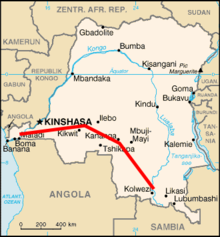Inga-Shaba

Route of the Inga–Shaba EHVDC in Democratic Republic of Congo
|
|
| Country | Democratic Republic of Congo |
|---|---|
| Coordinates |
05°31′27″S 13°36′39″E / 5.52417°S 13.61083°E 04°42′43″S 15°17′41″E / 4.71194°S 15.29472°E 05°06′39″S 18°47′06″E / 5.11083°S 18.78500°E 05°59′26″S 22°26′52″E / 5.99056°S 22.44778°E 08°44′43″S 24°52′30″E / 8.74528°S 24.87500°E 10°39′27″S 25°27′08″E / 10.65750°S 25.45222°E |
| From | Inga hydroelectric complex |
| To | Shaba (Katanga) |
| Operator | Société nationale d'électricité (SNEL) |
| Contractors | Morrison-Knudsen International, ASEA, Sadelmi-Cogepi, Irish GE subsidiary |
| Commissioned | 1982 |
| Type | overhead line |
| Type of current | HVDC |
| Total length | 1,700 km (1,100 mi) |
| Power rating | 560 MW |
| DC Voltage | +/-500 kV |
The Inga–Shaba EHVDC Intertie (officially: The Inga–Shaba Extra High Voltage D.C. Intertie; nickname: Inga–Shaba and also referred to as Inga–Kolwezi) is a 1,700 kilometres (1,100 mi)-long high-voltage direct current overhead electric power transmission line in the Democratic Republic of Congo, linking the Inga hydroelectric complex at the mouth of the Congo River to mineral fields in Shaba (Katanga). It was primarily constructed by Morrison-Knudsen International, an American engineering company, with the converter equipment supplied by ASEA. Construction was completed in 1982 and it cost US$900 million. The scheme was, for many years, the longest HVDC line in the world.
The Inga–Shaba HVDC represented one of the United States' most important third world commitments of the 1970s and 1980s. However, construction progress was plagued by rebel insurgency in Southern Zaire, massive logistical challenges, large cost overruns, and financing delays.
By utilizing the hydroelectric potential of the Inga Dam and by constructing one switching station near Kinshasa at Selo, the Government of Zaire under Mobutu Sese Seko was theoretically able to control the flow of power to secession-prone Katanga, then Shaba, province, but never actually exercised this option. It was reported in La Libre Belgique, a Brussels newspaper, that Tractionel, a Belgian electrical contractor, had argued that more economical alternatives were available nearer Shaba, using low-head generator plants, but had been overlooked in favor of the American consortium, consisting of Morrison-Knudsen International as a prime contractor, and Swedish ASEA, Italian Sadelmi-Cogepi and Irish GE subsidiary as sub-contractors.
...
Wikipedia
